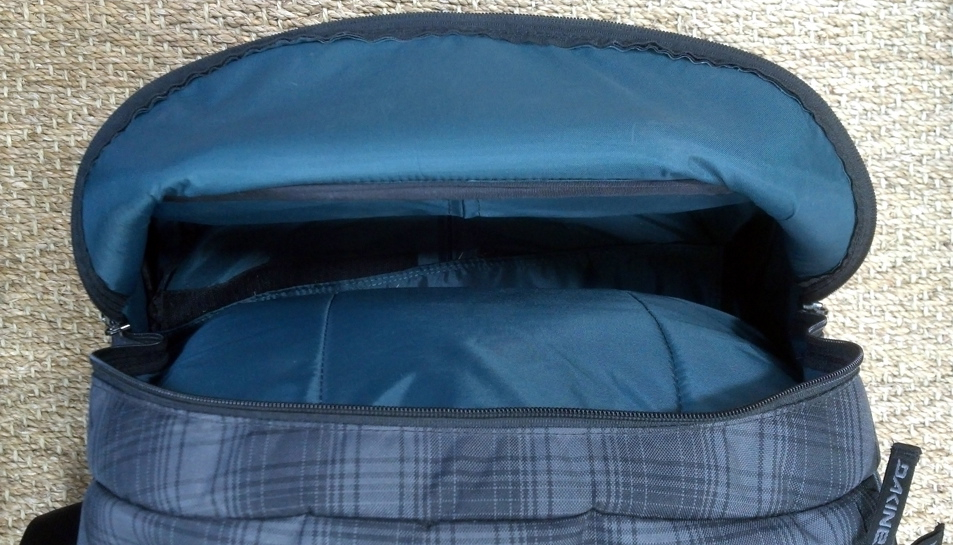Capacity / Weight
The Freewheeler Max’s capacity is impressive, and you can easily pack this bag to the brim with 65 lbs. of stuff and hit the road. Just keep in mind that if you’re getting on a plane, the standard airline weight limit is 50 lbs., so you might want to exercise a little restraint while packing.
When empty, the bag weighs 10.5 lbs., which is on the heavier side of the bags we’ve tested. But I’ve never wished I had a lighter bag, especially given how sturdy and user-friendly the Freewheeler Max is.
I’ve easily been able to pack enough clothes and gear for over two weeks of travel to South America. I’ve also packed all the clothes I’ve needed to live and work in NYC for an entire summer. If you’re looking for a bag to take abroad for a while, the Freewheeler Max will serve you very well—and it can also cinch down enough to be suitable for a shorter trip.
(Take a look at my packing list at the end of the review to get a sense of the amount of gear you can throw in the Freewheeler Max).
With a simple but flexible layout, the bag is particularly great for someone looking to carry a lot of out outdoor gear AND nicer clothes.
And if you don’t think you’ll need the Max’s 123 Liter capacity, but you like the sound of its durability and layout, then check out Patagonia’s regular Freewheeler, the smaller, 66 Liter version of the Freewheeler Max.
Alternatively, if you don’t think you’ll need this cavernous capacity; you don’t need to keep dress clothes separate and looking fresh; and you’re okay using sectioned compartments and tie-downs for many pieces of gear, then you’ll want to stay tuned for Jonathan’s review of the Osprey Shuttle 32. It’s another great bag that prioritizes organization and tidiness with tons of pockets and compartments, but may not be as ready to carry everything you’d need on a trip—from a jacket and slacks to goggles and skins.
Side Note: The Most Accurate & Practical Ways to Gauge “Capacity”
Volume—which is usually measured in liters or cubic inches—is not the best way to compare bags as you’re shopping. Volume numbers will only tell you very roughly how large a bag you’re dealing with is, but they don’t mean much as far as practical, useable space is concerned.
We recommend that you look first at outside dimensions—they’re a good gauge of bulk and size. But keep in mind that height measurement may be an inch or so greater than stated, given the flexibility of the main, top zippered panel of the bag.
But even more important than outside dimensions is the layout of the internal storage—how the internal space is used.
The shoe / dirty laundry compartments on both ends of the Dakine Wheeled Duffle are nice, but Patagonia’s use of a lower compartment is much better, because it disappears when you’re not using it. For the most part, the barrier is always there on the Dakine, which limits the way you’re able to use the interior space, and reduces the effective space of the main compartment by about 3” on each end.

Bottom Line
The Freewheeler Max is an amazing bag, but it doesn’t make much sense if you’re just looking for a basic piece of luggage. If you’re only looking for a bag to throw some ski gear into for a few ski trips over the next few seasons, the Freewheeler Max probably overkill, and you ought to consider the Dakine Wheeled Duffle.
But if you want something with a ton of capacity that’s likely to last for at least five or six years of regular, heavy use on ski vacations, family vacations, business trips, or as a storage container, then the Freewheeler Max is a very good long-term, gear-hauling investment.
And of course, if the bag ever does fail you—even in the form of normal wear and tear—Patagonia has you covered with their Ironclad Guarantee. But I fully expect to use this bag heavily for years and years to come without a problem.
Post Script (Packing List):
This is a list of everything I stuffed into the Patagonia Freewheeler Max on our review trip to Argentina last August. The bag weighed in at 48 lbs., with everything listed:
- 1 patagonia mid base layer
- 1 wool sweater
- 1 beanie
- 2 pairs of jeans
- 4 pairs of long underwear bottoms
- 4 thin baselayer tops
- 4 pairs of ski socks
- 5 pairs of regular socks
- 6 pairs of boxers
- 1 pair of basketball shorts
- 6 t-shirts
- 1 pair of gloves
- 2 pair of goggles
- 2 synthetic shirts
- 1 RED Mutiny helmet
- 1 pair of alpine trekkers
- 1 DSLR camera with charge cables
- 2 GoPros
- 1 pair of ski boot booster straps
- 1 tape measure
- 1 Hotronic portable boot dryers
- 1 set of travel plug adapters
- 1 16L avi pack w beacon, shovel, probe
- 1 Dopp Kit
